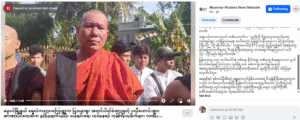(MMNN Editorial Commentary)
Throughout Myanmar’s long history, the Sangha has shaped the conscience of the nation. The robe carries deep moral power — capable of guiding kings and generals toward peace, or, tragically, toward justification of hatred.

In these troubled times, when war and nationalism once again threaten to overshadow compassion, the Buddha’s warnings in the Rogasutta seem written for today. They remind monks to beware of greed, vanity, and false pride — the inner diseases that destroy spiritual integrity.
When the Robe Becomes a Weapon
Recently, Senior General Min Aung Hlaing, reportedly troubled by sleeplessness and guilt over years of killing, sought counsel from leading monks.
Among them was Thidagu Sayadaw, one of Myanmar’s most influential clerics.
Instead of urging repentance and compassion, he echoed a distorted ancient tale, reassuring the general that the killings were not sinful — because, he said, most of those killed were not Buddhists.
He even claimed that only “two hundred Rohingyas” had been killed, and that such a number “did not amount to ethnic cleansing.”
This was not just political speech — it was the repetition of a dangerous moral myth that has haunted Buddhism for centuries.
The Ancient Parallel: The Mahavamsa and the Four Monks
The origins of this reasoning trace back not to Myanmar, but to ancient Sri Lanka, in the Mahavamsa — a Pali chronicle compiled centuries after the Buddha’s passing.
It tells of King Dutthagamani (Dutugemunu), who fought a bloody war said to have killed over 400,000 people.
After his victory, the King was stricken with remorse and insomnia, horrified by the mass killing.
According to the chronicle, four senior monks flew through the air to comfort him. Instead of encouraging remorse, they told him:
“Do not be troubled, O King. Of all those who were slain, only one and a half were true humans — true Buddhists. The rest were unbelievers.”
This teaching — that killing “infidels” carried no moral weight — contradicts the Buddha’s universal message of compassion.
Historians regard the Mahavamsa not as sacred scripture but as a nationalist legend that later kings used to justify wars in the name of Buddhism.
It was an early and tragic example of religion being used to bless bloodshed.
When Thidagu Sayadaw repeated a similar claim before Min Aung Hlaing — that most victims were non-believers, and thus their deaths were karmically negligible — he was reviving the same moral corruption born in that ancient story.
A Lesson from True History: Emperor Ashoka and the Kalinga War
In contrast to the mythical Dutthagamani tale stands a true, world-changing event: the story of Emperor Ashoka of India.
After the horrific Kalinga War, in which more than 100,000 lives were lost, Ashoka was overcome by deep remorse.
A humble monk confronted him, not with comfort, but with truth — reminding him of the immense suffering he had caused.
Ashoka’s conscience awoke.
He renounced violence entirely, embraced the Dhamma, and ruled henceforth as a servant of peace.
He built hospitals for people and animals, protected all faiths, and sent messengers of compassion across Asia.
His transformation — from conqueror to moral emperor — stands as the true Buddhist response to guilt and power.
Two Paths Before the Sangha
Today, Myanmar’s Sangha faces the same choice.
One path is that of Wirathu, Thidagu, and the Ma Ba Tha movement — monks who have mixed politics with the robe, sanctifying hatred and dividing citizens by faith.
The other path is that of Ashin Sandadika, Shwe Nya War Sayadaw, and Asia Alinyaung Sayadaw — monks who continue to preach humility, compassion, and interfaith respect even under pressure.
- Ashin Sandadika urges self-reflection and warns against arrogance within the Sangha.
- Shwe Nya War Sayadaw speaks out for justice and the protection of minorities.
- Asia Alinyaung Sayadaw lives quietly in the spirit of metta, helping the suffering without discrimination.
They embody what the Buddha truly intended monks to be — physicians for the pain of the world.
The True Role of Monks in Times of Conflict
The monk’s duty is not to bless power, but to awaken conscience.
When generals or rulers seek moral refuge, the monk’s role is not to excuse, but to enlighten.
Every killing, regardless of religion, is suffering — and every human life has equal worth.
A true monk heals a killer’s soul not by flattery, but by truth.
He turns remorse into repentance, not justification.
That is the Dhamma’s way.
Reclaiming the Compassionate Dhamma
Buddhism once spread across Asia not by the sword, but by Ashoka’s compassion.
If the Sangha of Myanmar remembers this, the robe will again become a symbol of light — not of fear.
The time has come for monks to choose between the legend of Dutthagamani and the truth of Ashoka,
between Thidagu’s distortion and Sandadika’s sincerity,
between a robe of pride and a robe of peace.
Only through truth and compassion can the Dhamma once again heal the wounds of our nation.





